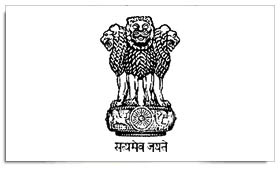Saturday, November 04, 2006
National Song
Vande Mataram!Sujalam, suphalam, malayaja shitalam,Shasyashyamalam, Mataram!Shubhrajyothsna pulakitayaminim,Phullakusumita drumadala shobhinim,Suhasinim sumadhura bhashinim,Sukhadam varadam, Mataram!
and in english translation is
I bow to thee, Mother,richly-watered, richly-fruited,cool with the winds of the south,dark with the crops of the harvests,The Mother!Her nights rejoicing in the glory of the moonlight,her lands clothed beautifully with her trees in flowering bloom,sweet of laughter, sweet of speech,The Mother, giver of boons, giver of bliss.
National Emblem
The State emblem is an adaptation from the Sarnath Lion Capital of Ashoka. In the original, there are four lions, standing back to back, mounted on an abacus with a frieze carrying sculptures in high relief of an elephant, a galloping horse, a bull and a lion separated by intervening wheels over a bell-shaped lotus. Carved out of a single block of polished sandstone, the capital is crowned by the Wheel of the Law (Dharma Chakra).
In the State emblem, adopted by the Government of India on 26 January 1950,only three lions are visible, the fourth being hidden from view. The wheel appears in relief in the centre of the abacus with a bull on right and a horse on left and the outlines of other wheels on extreme right and left. The bell-shaped lotus has been omitted. The words Satyameva Jayate from Mundaka Upanishad, meaning ‘Truth Alone Triumphs’, are inscribed belowthe abacus in Devanagari script.
Languages of India
There are 22 languages recognized by the Indian Constitution. These languages are
Assamese
Bengali
Bodo
Dogri
Gujarati
Hindi
Kannada
Kashmiri
Konkani
Maithili
Malayalam
Manipuri
Marathi
Nepali
Oriya
Punjabi
Sanskrit
Santhali
Sindhi
Tamil
Telugu
Urdu
Hindi is the official and main link language of India. Its homeland is mainly in the north of India, but it is spoken and widely understood in all urban centers of India. It is written in the Devanagri script, which is phonetic and, unlike English, is pronounced as it is written. Hindi is a direct descendant of Sanskrit through Prakrit and Apabhramsha. It has been influenced and enriched by Dravidian, Turkish, Farsi, Arabic, Portugese and English. It is a very expressive language. In poetry and songs, it can convey emotions using simple and gentle words. It can also be used for exact and rational reasoning.
wt u think after knowing about india its realy grate
ur
athakur
Subscribe to:
Post Comments (Atom)

No comments:
Post a Comment